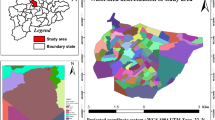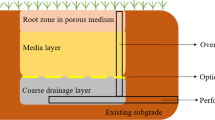Abstract
China is at present experiencing a very rapid urbanization process, which has brought a number of adverse impacts upon the water environment. In particular, urban runoff quantity and quality control have emerged as one of the key concerns for municipal officials. One of the strategies being considered is the use of a Low Impact Development type of Best Management Practices (LID BMPs) for urban storm water runoff quantity and quality control. In this paper, the situation surrounding urban runoff control in China is reviewed first. Then the conventional strategy and technologies for the construction and management of urban drainage systems are discussed, while exploring their inherent dilemmas. The LID BMPs are then introduced to control urban runoff in the context of urban sustainable water systems. After the comprehensive analysis of the various LID BMPs, the advances in LID BMPs research and practice for urban runoff control in China are investigated and summarized. At last, the difficulties of implementing LID BMPs in China are discussed, and a direction for the future is proposed.
Similar content being viewed by others
References
Wei H K. Qualitative urbanization and transformation in China. Shanghai Urban Planning Review, 2012, (4): 6–11 (in Chinese)
Chen M X, Lu D D, Zhang H. Comprehensive evaluation and the driving factors of China’s urbanization. Acta Geographica Sinica, 2009, 64(4): 387–398 (in Chinese)
Dietz M E. Low impact development practices: a review of current research and recommendations for future directions. Water, Air, and Soil Pollution, 2007, 186(1–4): 351–363
US EPA. National Water Quality Inventory, 2000 Report. Washington DC: US Environmental Protection Agency, EPA-841-R-02-001, 2002
Department of Environmental Resources of Prince George’s County. Low Impact Development Design Strategies: An Integrated Design Approach. Largo, MD: Department of Environmental Resources of Prince George’s County, 1999
Woods-Ballard B, Kellagher K, Martin P, Jefferies C, Bray R, Shaffer P. The SUDS manual. London: CIRIA, 2007
Wong T H F. Urban stormwater management and water sensitive urban design in Australia. In: Eric W S, Wayne C H, eds. Global Solutions for Urban Drainage. Reston: American Society of Civil Engineers 2002, 1–14
Ministry of Construction of the PRC. General Administration of Quality Supervision, Inspection and Quarantine of the PRC, Code for Design of Outdoor Wastewater Engineering (GB50014-2006). Beijing: China Planning Press, 2006 (in Chinese)
Silveira A L L. Problems of urban drainage in developing countries. In: Preccedings of the International Conference on Innovative Technologies in Urban Storm Drainage. Lyon: Novatech, 2001, v1: 143–150
Ellis J B, Ludwig J, Revitt D M, Dong Y H. Urban drainage management and eco-efficient water usage and wastewater options for Shenzhen City, SE China. In: Eric W S, Wayne C H, eds. Global Solutions for Urban Drainage. Reston: American Society of Civil Engineers, 2002, 1–10
Akan A O, Houghtalen R J. Urban Hydrology, Hydraulics, and Stormwater Quality — Engineering Applications and Computer Modeling. Hoboken: John Wiley & Sons, 2003
Hao T W. Effect on natural water system of urban construction and sustainable utilization of wastewater discharge system. Water & Wastewater Engineering, 2005, 31(11): 39–42 (in Chinese)
Xu C H. Reform of the urban drainage management system-a case study of Jilin City. Thesis for Master Degree. Changchun: Jilin University, 2012 (in Chinese)
Xie Y X. The trends of drainage planning in view of frequent urban waterlogging disasters. In: Proceeding of 2012 Annual Symposium of China Urban Planning. Kunming: Urban Planning Society of China, 2012 (in Chinese)
Davis A P. Green engineering principles promote low-impact development. Environmental Science & Technology, 2005, 39(16): 338A–344A
Li W, Shen Z Y, Tian T, Liu R M, Qiu J L. Temporal variations of heavy metal pollution in urban stormwater runoff. Frontiers of Environmental Science and Engineering, 2012, 6(5): 692–700
Councell T B, Duckenfield K U, Landa E R, Callender E. Tire-wear particles as a source of zinc to the environment. Environmental Science & Technology, 2004, 38(15): 4206–4214
Cappiella K. Stack W P, Fraley-McNeal L, Lane C, McMahon G. Strategies for Managing the Effects of Urban Development on Streams. Circular 1378. Reston: US Geological Survey, 2012
Wang L Z, Kanehl P. Influences of watershed urbanization and instream habitat on macroinvertebrate in cold water streams. Journal of the American Water Resources Association, 2003, 39(5): 1181–1196
Wang L Z, Lyons J, Kanehl P, Bannerman R. Impacts of urbanization on stream habitat and fish across multiple spatial scales. Environmental Management, 2001, 28(2): 255–266
Costanza R, d’Arge R, de Groot R, Farber S, Grasso M, Hannon B, Limburg K, Naeem S, O’Neill R V, Paruelo J, Raskin R G, Sutton P, van den Belt M. The value of the world’s ecosystem services and natural capital. Nature, 1997, 387(6630): 253–260
Zhang J, Cao X S, Meng X Z. Sustainable urban sewerage system and its application in China. Resources, Conservation and Recycling, 2007, 51(2): 284–293
US EPA. The Use of Best Management Practices (BMPs) in Urban Watersheds. EPA/600/R-04/184, Washington, DC: US Environment Protection Agency, 2004
Pyke C, Warren M P, Johnson T, LaGro J Jr., Scharfenberg J, Groth P, Freed R, Schroeer W, Main E. Assessment of low impact development for managing stormwater with changing precipitation due to climate change. Landscape and Urban Planning, 2011, 103 (2): 166–173
Sun Y W, Wei X M, Pomeroy C A. Review of current research and future directions of low impact development practices for storm water. Advances in Water Science, 2011, 22(2): 287–293 (in Chinese)
Xu Q X, Yang K, Xu S Y. Study on water environment effects and countermeasures for high_speed urbanization process in Shanghai. World Regional Studies, 2003, 12(1): 54–59 (in Chinese)
Hou P Q, Ren Y F, Wang X K, Ouyang Z Y, Zhou X P. Research on evaluation of water quality of Beijing urban stormwater runoff. Environmental Sciences, 2012, 33(1): 71–75 (in Chinese)
Huang G R, Nie T F. Characteristics and load of non-point source pollution of urban rainfall runoff in Guangzhou, China. Journal of South China University of Technology, 2012, 40(2): 142–148
Liu Y, Che W, Li J. Monitor-based evaluation of pollutant load from urban stormwater runoff in Beijing. Water Science and Technology, 2005, 52(9): 191–197
Xiao H W. Study on characteristic of urban runoff and the technology of constructed wetland for urban runoff treatment. Dissertation for the Doctoral Degree. Chongqing: Chongqing University, 2010 (in Chinese)
Ballo S, Liu M, Hou L J, Chang J. Pollutants in stormwater runoff in Shanghai (China): implications for management of urban runoff pollution. Progress in Natural Science, 2009, 19(7): 873–880
Dong X, Du P F, Li Z Y, Yu Z R, Wang Rui, Huang J L. Hydrology and pollution characteristics of urban runoff: Beijing as a sample. Environmental Sciences, 2008, 29(3): 607–612 (in Chinese)
Li L Q, Yin C Q, He Q C, Kong L L. First flush of storm runoff pollution from an urban catchment in China. Journal of Environmental Sciences-China, 2007, 19(3): 295–299
Zhang J J. Characteristics and loading estimates of heavy metals in urban rainfall runoff. Thesis for Master Degree. Shanghai: East China Normal University, 2011 (in Chinese)
Mei Y, Yang X H. The effect of nutrients removal for bioretention system in rainwater runoff. In: Proceeding of 2011 International Conference on Remote Sensing, Environment and Transportation Engineering (RSETE). Nanjing: Committee of 2011 International Conference on Remote Sensing, Environment and Transportation Engineering, 2011, 2:1791–1794
Jiang W. Mix design and road performance research on porous asphalt concrete. Thesis for Master Degree. Xi’an: Chang’an University, 2008 (in Chinese)
Zhu C Y, Li F, Li S H. Research on the influence of different pavement structures in landscape path on rainfall infiltration process. Chinese Landscape Architecture,2009, (3):91–97 (in Chinese)
Wang S M, Yu H, Zhang B, Shao L. Review of green roof in controlling unban nonpoint source pollution. Journal of Chongqing University of Arts and Sciences (Natural Science Edition), 2011, 30(4): 59–64 (in Chinese)
Wei Y P. Effects of city green roof on environment of water and temperature. Thesis for Master Degree. Changsha: Central South University of Forestry and Technology, 2010 (in Chinese)
Tang Y. Study of Urban Stormwater Runoff BMPs Planning with support of SUSTAIN system. Thesis for Master Degree. Beijing: Tsinghua University, 2010 (in Chinese).
Che W, Zhang W, Li J Q, Li H Y, Wang J L. Outline of some stormwater management and LID projects in Chinese urban area. In: Hao X D, Novotny V, Nelson V, eds. Water Infrastructure for Sustainable Communities: China and the World. London: IWA publishing, 2010, 161–174
Beijing Institute of Water. Research, Design and Demonstration on Water System and Rainwater Harvesting System in Beijing Olympic Green. Beijing: China WaterPower Press, 2009 (in Chinese)
Hu A B, Ding N, Ren X X. The principle and application of LID and the demonstration projects. In: Proceeding of 2012 Annual Symposium of China Urban Planning. Kunming: Urban Planning Society of China, 2012 (in Chinese)
Wang J L, Che W, Yi H X. Research and progress of stormwater management models based on low impact development. China Water and Wastewater, 2010, 26(18): 50–54 (in Chinese)
Wang W W, Zhao Z J, Qin H P. Hydrological effect assessment of low impact development for urbanized area based on SWMM. Acta Scientiarum Naturalium Universitatis Pekinensis, 2012, 48(2): 303–309 (in Chinese)
Jia H F, Lu Y W, Yu S L Planning of LID-BMPs for urban runoff control: The case of Beijing Olympic Village. Separation and Purification Technology, 2012, 84(SI): 112–119
Jia H F, Yao H R, Tang Y, Yu S L, Zhen J X, Lu Y W. Development of a multi-criteria index ranking system for urban stormwater best management practices (BMPs) selection. Environmental Monitoring and Assessment, doi: 10.1007/s10661-013-3144-0
Author information
Authors and Affiliations
Corresponding author
Rights and permissions
About this article
Cite this article
Jia, H., Yao, H. & Yu, S.L. Advances in LID BMPs research and practice for urban runoff control in China. Front. Environ. Sci. Eng. 7, 709–720 (2013). https://doi.org/10.1007/s11783-013-0557-5
Received:
Accepted:
Published:
Issue Date:
DOI: https://doi.org/10.1007/s11783-013-0557-5




